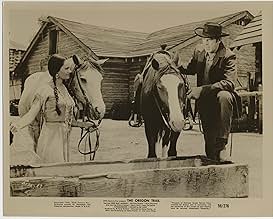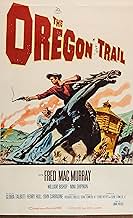Adicionar um enredo no seu idiomaIn 1846, a newspaperman joins an Oregon Trail wagon train to verify rumors about the U.S. government sending troops disguised as settlers there in order to claim Oregon.In 1846, a newspaperman joins an Oregon Trail wagon train to verify rumors about the U.S. government sending troops disguised as settlers there in order to claim Oregon.In 1846, a newspaperman joins an Oregon Trail wagon train to verify rumors about the U.S. government sending troops disguised as settlers there in order to claim Oregon.
- Direção
- Roteiristas
- Artistas
Avaliações em destaque
Fred is the lead, though, working undercover to find secret bad guys, wooing women, and learning how to cope with dust in his trousers and sleeping on the dirt. If you're a fan, you'll like seeing him in this City Slickers-esque movie. Keep in mind it's not a comedy, though. There are some tense situations, trigger-happy grumps, and violin strings playing whenever Granny Elizabeth Patterson says she knows she'll make it through the entire ride. John Carradine portrays Johnny Appleseed, and there's a particularly sad scene when his trees get attacked. Personally, I found this movie too sad to be enjoyable. You might want to try the Lewis and Clark biopic The Far Horizons instead.
Things begin unpromisingly with a scene involving President Polk in Washington D.C. This scene tries to give the story a historical context but it's on the dull and talky side. This is followed by another lax scene in which dapper, man-about-town reporter, Fred MacMurray, is assigned to go west on a wagon train and write a story for his newspaper. Finally, as MacMurray arrives in Westport, Missouri -- the eastern start of the Oregon Trail -- things begin rolling. They do so in a conventional way, however, and the entire trek west is filled with the usual situations: troubling encounters with Indians, dry water holes, tensions among the folk on the wagon train, an unexpected rain storm, a funeral service by the side of the trail, a settler protecting his apple-tree seedlings, etc. The use of stock shots and indoor sets hamper the effects of many of these scenes and there's no real villain to conflict with Fred MacMurray. There's also no tension about his mission since he makes no effort to hide it and the possible romantic- triangle involving him and William Bishop and Nina Shipman never takes form. Instead, MacMurray is implausibly paired with Gloria Talbott who appears fairly late in the proceedings.
Action builds toward a last-reel Indian attack which now seems quite "politically incorrect." (The "half-breed" Indian girl implausibly says: "It is because of this, I renounce my people.") Perhaps the only notable thing about "The Oregon Trail" is the scene in which Indians capture Fred MacMurray, strip off his shirt, and stake him out to die. (For a man in his early 50s, MacMurray looks pretty good bare-chested!) While TV westerns often staged these stake-outs, they're not all that common in the movies, and who'd believe one of them would "star" an actor about to get a career boost by playing in Disney comedies?!
Let's mention some of the many anachronisms in this film. The movie talks about the new 'Colt revolver' and show the soldiers using them in 1846. But Samuel Colt didn't make his prototype revolver in 1847 and didn't even open up his own company until 1855...so there would have been no Colt revolvers in 1846. The same goes for the repeating rifles you see in the movie...they didn't come out until about 1860 and were very rare even then....but the natives and soldiers all seem to have them! And, it's not just about weapons...at one point Fred MacMurray's character talks about sending a telegraph from out west to his employers on the East Coast. But the telegraph was never used until 1844 and telegraph wires didn't make it West until a decade later.
But anachronisms aren't the only problem in the film. President Polk had long hair and styled it in a mullet....but here he's nearly as bald as Kojak! And, often characters do things that simply make no sense...such as MacMurray's character defending a thief even when it's obvious the guy is stealing as well as his crazy fight with the guy with a whip early in the movie. The nasty guy is whipping the snot out of people and Fred is literally standing NEXT to the guy. But instead of socking him then, he backs up...thus allowing the whipper to whip him!! Who is THAT stupid??!! Fred....when you are standing NEXT to a guy with a whip, he cannot use it on you....get it?! Apparently not. Such is the care the writers and director took in making this film. And these little details are why I was not enthralled with this movie.
If you care, here is the plot: Fred plays Neal Harris, a reporter from back East. There's a rumor that President Polk is sending soldiers disguised as settlers into the disputed Oregon Territory. He heads there in a wagon train to determine if the rumor is true. Along the way, there's a lot of nonsense and really, really bombastic music!
Overall, this is a sloppy film and one I'd just as soon skip. There are far better westerns and far better Fred MacMurray films out there!
Você sabia?
- CuriosidadesThis was William Bishop's last role and last movie.
- Erros de gravaçãoIn scenes at the White House, President James K. Polk stands in front of a US map, but the map shows the US following the Compromise of 1850. The film is set in 1846, before the Texas border was changed, before the Mexican Cession resulted in the admission of California and the organization of the Territories of Utah and New Mexico, all of which are clearly seen on that map.
- Citações
Neal Harris: Questions seem to bother you a lot, Mr. Wayne.
Capt. George Wayne: Only the man who asks them.
Neal Harris: Well, that's too bad because my livelihood happens to depend on questions.
Capt. George Wayne: Then I suggest you go back East and ask them. Out here, questions can get you killed.
- ConexõesReferenced in As Poltronas do Cine Alcazar (1989)
Principais escolhas
- How long is The Oregon Trail?Fornecido pela Alexa
Detalhes
- Tempo de duração1 hora 26 minutos
- Cor
- Proporção
- 2.35 : 1
Contribua para esta página































